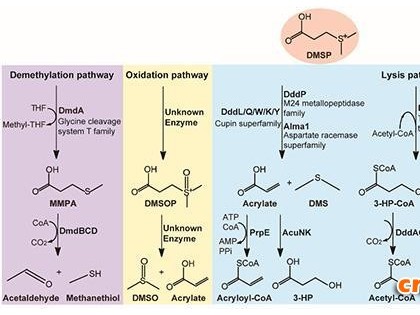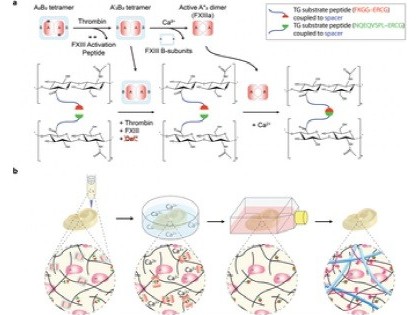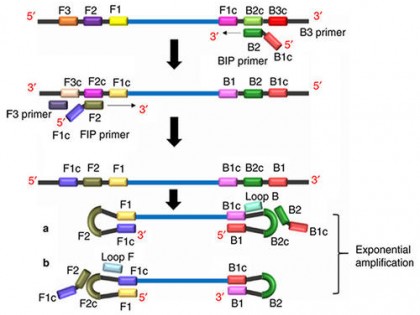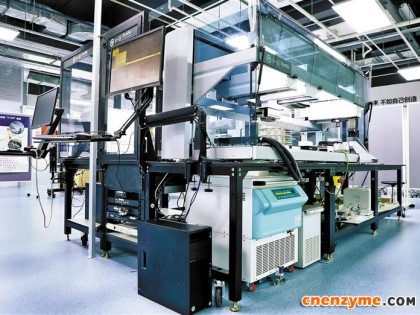11月10日,Biochemical Journal在线发表了上海生科院生化与细胞所丁建平组关于酿酒酵母组蛋白去甲基化酶Rph1底物特异性识别和催化机制的研究成果。
人和酵母等真核生物中存在一类含有JmjC结构域的蛋白家族,研究表明它们中的许多成员具有组蛋白去甲基化酶活性,并且都利用Fe2+和α-酮戊二酸为辅因子。人源JMJD2A可以特异性的去甲基化H3K36me3/2和H3K9me3/2。Rph1是人源JMJD2A在酿酒酵母中的同源物,可以特异性的去甲基化H3K36me3/2,这种活性在某些转录激活基因的转录延伸过程中发挥重要的促进作用。
丁建平组的博士生常媛媛等人解析了Rph1催化核心区域的结构,以及与Ni2+和α-酮戊二酸的复合物的结构。其中,Ni2+用来模拟Fe2+的结合形式。Rph1的催化核心区域具有与全长蛋白一样的组蛋白去甲基化酶活性和底物特异性。这些结构揭示Rph1催化核心区由JmjN结构域、长的b-发卡结构、由a-螺旋和环状区域形成的混合结构域、和JmjC结构域构成。在催化核心中心,Ni2+通过与三个保守的氨基酸(His235,Glu237和His323)和a-酮戊二酸形成配位键来稳定其结合,同时a-酮戊二酸还以与三个保守氨基酸(Tyr183,Asn245和Lys253)的侧链形成氢键作用。根据Rph1核心区的结构与JMJD2A核心区结合H3K36me3肽段复合物的结构比对,我们推测Rph1的底物结合位点位于核心区域的表面,主要由长的b-发卡结构、a-螺旋和环状区域形成的混合结构域、以及保守的JmjC结构域构成;甲基化的H3K36可以伸入到JmjC结构域形成的口袋中,通过与几个保守氨基酸的氢键作用来稳定其结合。基于这些分析和比较,结合点突变、体外组蛋白去甲基化酶活检测和酵母表型筛选实验,我们发现突变与Ni2+、a-酮戊二酸和肽段结合位点的氨基酸后,Rph1丧失酶活性,同时也丧失在酵母体内促进转录延伸的功能、从而导致酵母生长缺陷。以上的研究结果揭示了酿酒酵母中组蛋白去甲基化酶Rph1底物特异性识别和催化机制。
该项工作得到国家科技部、国家自然科学基金委、中国科学院和上海市科委的经费支持。(生物谷Bioon.com)
生物谷推荐英文摘要:
Biochem. J. (2010) Immediate Publication, doi:10.1042/BJ20101418
Crystal structure of the catalytic core of Saccharomyces cerevesiae histone demethylase Rph1: insights into the substrate specificity and catalytic mechanism
Yuanyuan Chang, Jian Wu, Xia-Jing Tong, Jin-Qiu Zhou and Jianping Ding
Institute of Biochemistry and Cell Biology, Shanghai Institutes for Biological Sciences, SHANGHAI 200031, People‘s Republic of China. jpding@sibs.ac.cn
Saccharomyces cerevesiae Rph1 is a histone demethylase orthologous to human JMJD2A that can specifically demethylate tri- and dimethylated Lys36 of histone H3. The catalytic core of Rph1 (c-Rph1) is responsible for the demethylase activity which is essential for the transcription elongation of some actively transcribed genes. We report here the crystal structures of c-Rph1 in apo form and in complex with Ni2+ and α-ketoglutarate (α-KG). The structure of c-Rph1 is composed of a JmjN domain, a long β-hairpin, a mixed structural motif, and a JmjC domain. The α-KG co-factor forms hydrogen-bonding interactions with the side chains of conserved residues, and the Ni2+ ion at the active site is chelated by conserved residues and the cofactor. Structural comparison of Rph1 with JMJD2A indicates that the substrate-binding cleft of Rph1 is formed with several structural elements of the JmjC domain, the long β-hairpin, and the mixed structural motif; and the methylated Lys36 of H3 is recognized by several conserved residues of the JmjC domain. In vitro biochemical data show that mutations of the key residues at the catalytic center and in the substrate-binding cleft abolish the demethylase activity. In vivo growth phenotype analyses also demonstrate that these residues are essential for its functional roles in transcription elongation. Taken together, our structural and biological data provide insights into the molecular basis of the histone demethylase activity and the substrate specificity of Rph1.





